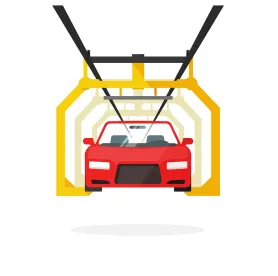The Federal Communications Commission (“FCC”) has a key role to play in driving the development of connected and automated vehicles (“CAV”) technology. As we explained in a recent CAV IoT Update, the FCC has been studying the risks associated with specific CAV technologies that could provide unique channels for potential cyberattacks. This post examines the debate over spectrum allocation for CAV technologies.
Why the FCC Matters to Connected and Autonomous Vehicle Technology
The FCC makes critical decisions about what portions of the radio spectrum will be available for various fifth-generation (“5G”) and other new wireless services, including CAV technologies. Those decisions are part of the FCC’s authority to administer spectrum for use by states, local governments, commercial businesses, and consumers. While the FCC at one time had designated a specific band of spectrum, the 5.9 GHz band for vehicle-to-vehicle (“V2V”) communications, a debate recently was reignited over the future of that band and the best way of enabling spectrum for CAV technologies and for the broader range of next-generation technologies that will be available with deployment of 5G. Although the 5.9 GHz band is not the only portion of the spectrum that enables CAV technologies, it has attracted significant interest from, and debate among, automakers, wireless providers, chip manufacturers, WiFi advocates and others. These stakeholders are debating whether having one band dedicated to CAV is the most efficient and effective means of meeting demands in this country for spectrum access—demands that the recent Presidential Memorandum on national spectrum policy described as “never . . . greater than today, with the advent of autonomous vehicles and precision agriculture, the expansion of commercial space operations, and the burgeoning Internet of Things.”
The Debate: FCC’s Allocation of the 5.9 GHz Band for Dedicated Short Range Communications
In 1999 the FCC first allocated the 5.9 GHz band for a type of wireless communication technology, known as Dedicated Short Range Communications (“DSRC”), which enables V2V and vehicle-to-infrastructure (“V2I”) information transfers. In 2004, when the FCC adopted licensing and service rules for DSRC services in the 5.850 to 5.925 GHz band of the spectrum, its Report and Order explained that DSRC, “provides the critical communications link for intelligent transportation systems,” which are designed to “reduc[e] highway fatalities” and “save lives by warning drivers of an impending dangerous condition or event in time to take corrective or evasive actions.”
Today, the 5.850 to 5.925 GHz band is still allocated for DSRC-based technologies, although an FCC proceeding to consider reallocation of the band has been open for more than five years. At issue are the extent to which: (i) the band should continue to be allocated solely for DSRC and whether that exclusive allocation was necessary; (ii) the band should be preserved for additional automotive technologies; and (iii) the band should be repurposed, partially or entirely, to meet increasing demands for additional unlicensed spectrum and whether CAV technologies could make use of other bands.
Renewed Focus: Questions over Use of the 5.9 GHz Band are Revisited this Fall
The FCC proceeding has received renewed attention this fall. First, NCTA—the Internet & Television Association, which represents the cable industry, issued a letter in October, arguing that the FCC should “conclude its 5.9 GHz proceeding” by issuing “a Further Notice of Proposed Rulemaking or other appropriate vehicle that: (1) recognizes that the heavy-handed, technology-specific rules of the past have failed, (2) proposes to open all or a sufficient portion of the band to promote unlicensed innovation and investment, and (3) considers how to more flexibly address the need for low-power, point-to-point connectivity in the automotive sector using one or more alternative spectrum bands.”
According to the NCTA, “[t]he marketplace has rejected DSRC” because, first, automakers are “concerned about DSRC’s effectiveness,” second, market-driven alternatives, including cellular vehicle-to-everything technology (“C-V2X”) “are flourishing,” and, third, “conversations about the future of automobile safety have shifted to autonomous vehicles, which today rely on LIDAR [light detection and ranging], cameras, sensors, and radar, potentially supplemented by V2X communications as an additional sensor input.” NCTA also cited the Department of Transportation’s (“DOT”) recent guidance, which we previously covered in another IoT Update, for the proposition that DOT “has shifted focus from DSRC to technology-neutral standards.” DOT’s guidance caused some public confusion about the Department’s stance on repurposing the 5.9 GHz band, but DOT recently clarified in a press release that “[p]reserving the 5.9 GHz band for transportation communications is essential to public safety today and in the future.”
Even within the automotive industry, there is debate over the right course. Some automakers have emphasized DSRC as the right technology for CAV vehicles, while another group has suggested moving beyond DSRC in favor of C-V2X standards.
As companies are debating whether re-allocating the band will lead to interference with DSRC, the FCC’s Office of Engineering and Technology (“OET”) is studying the issue. At the end of October 2018, that office released a request for comment on a recent report of tests OET performed to evaluate potential sharing solutions between unlicensed devices and DSRC operations in the 5.9 GHz band. Through testing, OET found that prototype unlicensed devices, which provide short-range, high-speed unlicensed wireless connections for applications such as Wi-Fi-enabled radio local networks, cordless telephones, and fixed outdoor broadband transceivers used by wireless internet providers, are “reliably” able to detect DSRC communications. OET reported that the unlicensed devices could prevent interference by detecting DSRC signals and either vacating or sharing portions of the spectrum. The FCC sought comments, which were due by November 28, 2018, to address whether the test results, which suggest that DSRC-based technologies and unlicensed devices can co-exist, should impact the pending proceeding regarding use of the 5.9 GHz band. Notably, the FCC has adopted a similar “listen-before-talk” spectrum protocol in other bands. Outside of the proceedings, FCC Commissioner O’Rielly has stated that he “is confident that at least 45 megahertz” in the 5.9 GHz band “can be reallocated for unlicensed services without jeopardizing automobile safety.”
Broader Implications: CAV Technology and the Race Toward 5G Deployment
The extent to which the 5.9 GHz band should be used for unlicensed services (as opposed to just DSRC or other automotive technologies) exemplifies the larger debate over how and in which bands the FCC should allocate additional spectrum to facilitate 5G deployment. 5G wireless technologies, which are designed to enable wireless broadband services with faster speeds and low latency (i.e., minimal delay in processing data), have received much attention recently, including in this fall’s Presidential Memorandum on national spectrum policy, which announced “it is imperative that America be first in fifth-generation (5G) wireless technologies.”
As we have explained previously in an IoT Update, the rollout and success of 5G networks has significant implications for the future of the IoT ecosystem, which includes CAV technologies. Because 5G promises wireless broadband services with faster speeds and low latency, the deployment of 5G may, for instance, enable cars to collect and share greater amounts of data at a quicker pace, thereby improving driver experiences and equipping cars with more rapid reflexes.
To spur 5G deployment, the FCC has introduced the Facilitate America’s Superiority in 5G Technology strategy (“5G FAST Plan”) to make additional spectrum available for 5G services, including through spectrum auctions, which we also have discussed previously in another IoT Update. The first auction began November 14, 2018, for high-band spectrum in the 28 GHz and 24 GHz bands, but the FCC also is considering, inter alia, reallocation of mid-band spectrum, which could eventually include the 5.9 GHz band. Repurposing the 5.9 GHz band for 5G uses beyond DSRC and other automotive safety technologies would not only make a block of spectrum available for additional unlicensed wireless technologies, but it may also enable a larger speed way of spectrum to be available across bands to enhance the overall effectiveness of 5G deployment.
Next Steps: Looking Forward on the 5.9 GHz Band
As noted, the FCC sought comments on its recent OET tests this month, and replies are due by December 13, 2018. The OET report was part of Phase 1 of a three-phase test plan announced in 2016, and the current request for comments, in addition to asking commenters to address the report and the pending proceeding on unlicensed use in the 5.9 GHz band, also specifically asks commenters to weigh in on whether the report should impact the three-phase test plan. Meanwhile, the FCC has issued a Notice of Proposed Rulemaking to “propose rules that will promote new opportunities for unlicensed use in portions of the” neighboring 6 GHz band, with comments due 60 days after publication in the Federal Register. Given that the 5.8 GHz band, the 5.9 GHz band’s lower-adjacent neighbor, permits significant unlicensed operations, stakeholders, such as the NCTA, have argued that, if the FCC permits additional unlicensed activities in the 6 GHz band, “DSRC . . . or any specialized automotive technology,” will remain “as an unsustainable technological island.”




 />i
/>i

